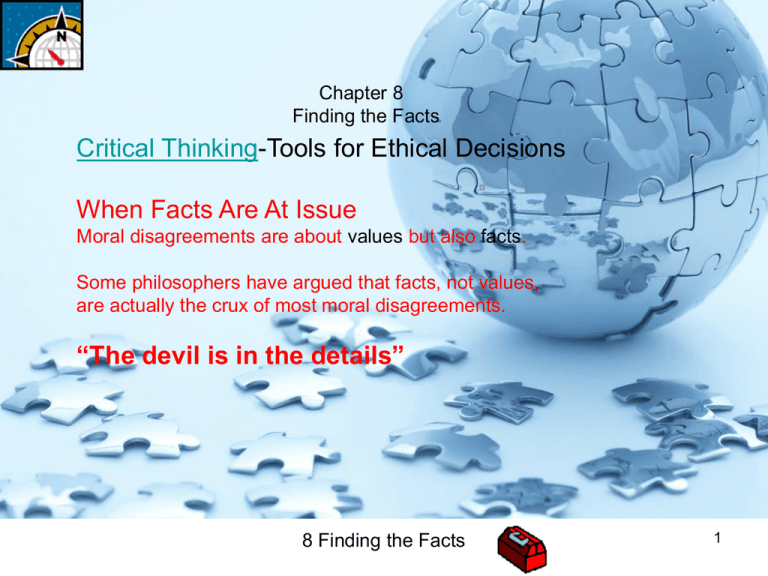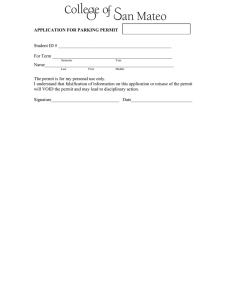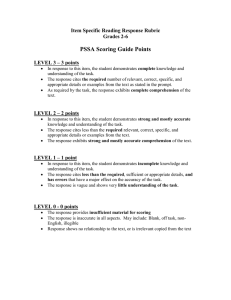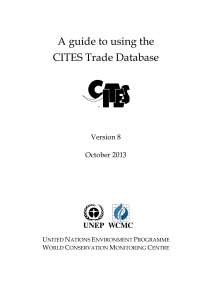Critical Thinking -Tools for Ethical Decisions When Facts Are At Issue
advertisement

Chapter 8 Finding the Facts Critical Thinking-Tools for Ethical Decisions When Facts Are At Issue Moral disagreements are about values but also facts. Some philosophers have argued that facts, not values, are actually the crux of most moral disagreements. “The devil is in the details” 8 Finding the Facts 1 Chapter 8 Finding the Facts What Facts Are At Issue? Facts can be confusing, misleading and inaccurate. Three kinds of statistics Death Penalty—Why does society permit it? Critical Thinking Questions What facts/evidence support its use? What societies have it and which societies do not? What are the comparisons? How would you get evidence for or against the claimed deterrence effect? Other critical thinking questions? 8 Finding the Facts 2 Chapter 8 Finding the Facts What Facts Are At Issue? Gun Control Why does society permit it? Critical Thinking Questions How many lives, for example, do guns take? Compare other countries, what are the facts? Who has it and who does not have it. What is the evidence? Other critical thinking questions? 8 Finding the Facts 3 Chapter 8 Finding the Facts What Facts Are At Issue? Marijuana- Why doesn’t society permit it? Critical Thinking Questions What would happen if marijuana use were legalized? How do we find out? Can we make comparisons with other countries? How dangerous is the stuff? Other critical thinking questions? 8 Finding the Facts 4 Chapter 8 Finding the Facts What Facts Are At Issue? Women in the military Why does society permit it? Critical Thinking Questions What actually have been the results of women in fighting positions in the military? Have they jeopardized the safety of fellow soldiers or marines? What affect does it have on families? Is it different than men? Other critical thinking questions. 8 Finding the Facts 5 Chapter 8 Finding the Facts Getting the Facts. Some issues are simple while others are quite complex to discover facts. Question: What percent of the federal budget goes to “welfare”? Means tested by income: Food stamps, unemployment compensation, welfare block grants to states, child nutrition programs and Medicaid. Results: 12% (1996) Entitlement Social security, veterans’ benefits, Medicare, earned income tax credits, student loans and grants, refugee assistance, etc. Results: 60% (1996) 8 Finding the Facts 6 Chapter 8 Finding the Facts Getting the Facts. Studies can show opposites occurring. Conflicting data. What appears to be “obvious” is not. Look deeper! Capital punishment Increased and decreased No absolutes in conclusions Don’t give up! No evidence or just opinions is morally irresponsible 8 Finding the Facts 7 Chapter 8 Finding the Facts Sources: Library/Librarians Books and Journals Ethics Web sites Peer Review –Get Both Sides of the Story Author’s credentials Research Impartial Scientific Journals Tone of sources, extreme or simplistic, attacking, demeaning Arguments on both sides presented Media bias 8 Finding the Facts 8 Chapter 8 Finding the Facts Inferences Facts to conclusions Generalizations Small sample-limited data, a few examples-to stand for the whole. Good generalizations do three things: 1. Cites specific and clear examples. 2. Cites many examples. More than antidotal 3. Cites representative examples, not all of one type, and give enough background information to allow us to evaluate for ourselves how significant and representative the examples are. Example: Innocent death row inmates are executed 8 Finding the Facts 9 Chapter 8 Finding the Facts Comparisons Seemingly similar situations A good comparison does two things: 1. Cities as a comparison a clear case about which true claims are made. 2. Cites as a comparison a relevantly similar case. Example Argument: Gun control in the United States is necessary since it reduces homicides in Singapore. Is the comparison valid? 8 Finding the Facts 10 Chapter 8 Finding the Facts Inferring Cause from Correlation Cause and effect relationship Example Violence on TV correlates with real-life violence. A good argument from correlation to cause: 1. Cities accurate correlations 2. Explains how the (proposed) cause leads to the (proposed) effect 3. Argues that the proposed cause-effect relationship is the best explanation of the correlation. A&B 8 Finding the Facts 11 Exercises and Notes: Identify the Facts at Issue Page 144 Finding the Facts Page 145 8 Finding the Facts 12




